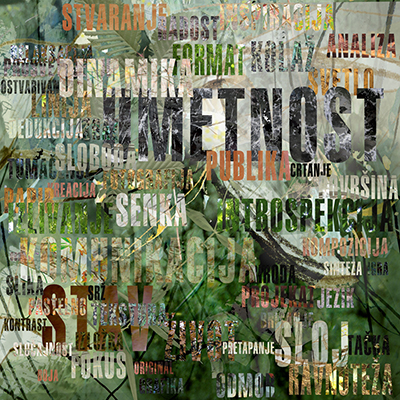Vesna Opavský’s project Art as a Keyword is an exploration of the expressive potentials of infographic text processing, aimed at emphasizing the notional and social aspects of art within the IT phenomenology. Contrary to the ubiquitous textual interventions in the work of art, that often indicate artists’ frustration in realizing their intentions by abstract visual means, Art as a Keyword transforms the text—its generation, consumption and implications—into a thematic and poetic platform by utilizing the abstraction of the programming code which is, at the certain level, also textual.[1] The elaborate formal and procedural treatment of the interactive and printed elements of the presentation reflects the artist’s enthusiasm for digital reexamination of intimate motives, but can also be interpreted as an ironic comment on the fetishizing of technology through the concept of omnipotent information.[2]

Vesna Opavský, Art, digital print, 2013.
The project is essentially visualized with word clouds, hierarchized by the frequency of appearance. In the mid-2000s, word clouds were introduced by such ‘web 2.0’ entrepreneurial projects as the social indexing service del.icio.us, and the photo- and video-sharing service Flickr. The choice of infographic solution with such pedigree in Art as a Keyword indicates that today’s experience of the Internet primarily refracts through the focus of social networks. The Internet belongs to the companies which possess the infrastructure and control the protocols of major (social) networks, and not to the users who keep them alive by voluntarily contributing content and freely participating in the commercially mediated interactions.[3] In other words, the ‘opening’ of media systems on the Internet signifies a transition towards a new mode of structuring information and material resources, which finds its corresponding regime in art,[4] notably in digital infographics.
Digital infographics uses software tools to collect, process and present data thus opening the new aspects of its analysis and contextualizing. With the idea that data is not neutral, many infographic artists believe and/or claim that their work is dedicated to the responsible[5] creation of projects which make invisible things visible.[6] Nevertheless, the ethics of infographics is determined by those things that the visualization renders or keeps invisible. The digital interface—hardware architectures, programming frameworks and protocols—as well as the infographic mechanisms for collection, organizing and presentation of data, represent filters defined by specific criteria.[4] They, among other things, censor the inequalities, violence and crimes out of which the data is born, without offering the solutions for their prevention, except—occasionally—the hints for their more efficient management.[7] Popular infographics represents a new form of infotainment or the spectacularization of the ‘higher’ interests of cognitive capitalism.[8]
Reflecting the priorities of flow and virtualization of transactions in cognitive capitalism,[9] the cultural sector treats the artists primarily as creators of inspirational (aesthetic) contents, events and identities. The artist becomes the ‘immaterial’ laborer, charged with creation, manipulation and presentation of affects,[10] while the combination of social networking and continuous realization of projects becomes a model for a successful career.[11] Similarly to the way that affect is waning in the social networks due to its absolute rationalization in software,[4] affect is waning as an essential artistic product due to the inflationary rationalization of artistic thinking and process within market conventions and operational models of the art scene. At the same time, the epistemological and political impact of art is significantly inferior to that of science and technology which provide the most significant knowledge about the (human) nature and establish global trends.[12]
Art is becoming an evasive term not because of the etheric nature of artistic experience, but because of the cognitive and political irrelevance of artistic production. By filtering it infographically, Vesna Opavský reveals the pragmatic cynicism of the digital paradigm and the banality of social relations, political and technological agendas that are shaping the today’s world. In this world, a similar demystification could be achieved by infographically touching the notions such as responsibility, trust, acknowledgement, empathy, happiness.
-
The project was realized using PHP and C++ (Google Custom Search API) programming languages, JavaScript scripting language, MySQL relational database management system, and REST (Representational State Transfer) communication protocol. ↩
-
Theodore Roszak. The Cult of Information: A Neo-Luddite Treatise on High-Tech, Artificial Intelligence, and the True Art of Thinking. Berkeley, CA: University of California Press, 1994. ↩
-
Dmytri Kleiner & Brian Wyrick. "Info-Enclosure 2.0." in Proud to be Flesh: A Mute Magazine Anthology of Cultural Politics After the Net, authors Josephine Berry Slater & Pauline van Mourik Broekman. London: Mute Publishing / Autonomedia, 2009: 66. ↩
-
Alexander R. Galloway. The Interface Effect. Cambridge, UK: Polity, 2012. ↩
-
Jen Lowe, Laura Kurgan, Maya Ganesh & Jake Porway. Lightness and Weight, Data and Social Justice. Minneapolis, MN: Eyeo Festival, 2013. ↩
-
Fernanda Viergas & Martin Wattenberg. Digital Arts @Google: Fernanda Viergas & Martin Wattenberg & W. Bradford Paley. New York, 2010. ↩
-
Julian Stallabrass. "Empowering Technology: The Exploration of Cyberspace." in Gargantua, author Julian Stallabrass. London / New York: Verso, 1996: 47. ↩
-
Some of the most talented infographic artists and studios work for the major news and media companies such as The New York Times, The Wall Street Journal, Corriere della Sera, CNN, BBC. ↩
-
Manuel Castells. The Rise of the Network Society. Chichester, UK: Wiley-Blackwell, 2010: 100. ↩
-
Charlie Gere. Digital Culture. London: Reaktion Books, 2008: 166. ↩
-
Artur Żmijewski. Forget Fear. Berlin: Berlin Biennale, 2012: 10-18. ↩
-
Douglas Adams. Richard Dawkins: Break the Science Barrier. TV show. BBC. 1996. ↩
Vesna Opavský, Art as a Keyword exhibition catalogue, Belgrade: Dom omladine Belgrade, 2013.
Sense of the Word Art. Belgrade: Politika, Culture – Art – Science No. 26/LVII, 12 October 2013: 6.